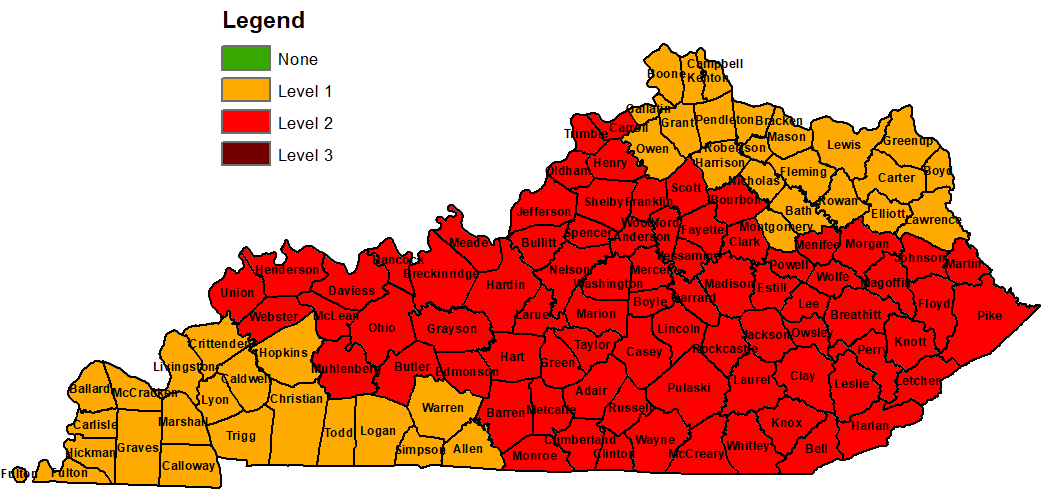Kentucky Facing Unprecedented Drought
Posted on Oct 7, 2019FRANKFORT, Ky. (October 03, 2019) – The Office of the State Climatologist and the Kentucky Energy and Environment Cabinet, in coordination with the Kentucky Drought Mitigation Team, are issuing a Level 2 for 78 counties and a Level 1 drought declaration for 42 counties.
A Level 2 Drought Declaration indicates severe drought conditions have developed. Severe impacts to water-sensitive enterprises, depletion of water supplies in shallow wells, springs, and ponds, increased incidences of wildfires, and water conservation advisories from communities with drought-vulnerable supplies can be expected in the designated areas.
A Level 1 Drought Declaration indicates moderate to severe drought conditions have developed primarily affecting soil moisture and vegetative health. Serious impacts to agricultural water needs, an increased wildfire risk, abnormally low flows in streams and decreased water quality can be expected in the designated areas.
The current Level 2 Drought Declaration has been issued for areas of significant, widespread dryness that have suffered substantial agricultural losses, loss of streamflows in many small streams and rivers and increases in the occurrence of wildfires. If drought conditions persist, it is expected that some water utilities will have difficulties treating water and/or begin requiring mandatory water restrictions due to low water supplies
The current Level 1 Drought Declaration has been issued for areas in western and north eastern Kentucky to cover areas that have widespread dryness. Impacts in the declared counties, while not as severe, are still significant, especially in regard to agriculture and the occurrence of harmful algal blooms (HABs). Caution should be taken before interacting with any water body that has algal blooms present. A map of current advisories for HABs can be found at http://watermaps.ky.gov/HAB.

Kentucky has been experiencing unprecedented dryness with most locations recording little to no precipitation during the month of September. This lack of precipitation, combined with record heat, has led to rapidly deteriorating conditions
“The combination of hot, dry weather that set in across Kentucky in August reached an unprecedented level during September based on the period of record dating back to 1895. As a result, drought conditions have developed rapidly as we enter what is climatologically the driest time of the year.” Stu Foster, state climatologist for Kentucky
The hot, dry conditions have had a devastating impact on agricultural interests, especially when it comes to cattle production.
"September 2019 will likely be the driest September we’ve ever seen in Kentucky. Data at the Ag Weather Center shows the state only averaged 0.28 inches for the month. The lack of rainfall and excessive heat has produced numerous impacts on the agricultural side. Severely diminished pasture conditions has led to limited fall grazing, and in turn, forced many producers to feed winter hay well ahead of schedule. Numerous county agents are reporting hay yields cut in half, while moisture availability has put a halt to pasture renovations. Farm ponds, streams, and continue to diminish tremendously, which has pushed some producers to start hauling water." Matt Dixon, UK Ag Weather Center.
Statewide, public water supplies are not seriously affected, at this point, but persistent drought conditions will increase the risk of water shortage conditions, especially for those systems relying on small lakes, small headwater streams and wells located in small groundwater sources. Low water levels in lakes can also lead to deteriorating water quality issues that could make the water difficult or impossible to treat. The Kentucky Division of water will continue to monitor all the state’s water systems and their sources of supply and notify the public of any changes that may lead to water shortages
The forecast currently shows relief from the record heat starting on Friday with a chance of widespread rainfall early next week. This does not appear to be a drought busting rain, but any amount of precipitation will be beneficial. The long-term outlooks show dry conditions returning and potentially persisting through at least October.
The Kentucky Drought Mitigation and Response Plan defines a tiered approach to classifying drought severity using multiple indicators to assess the intensity and location of developing drought. These indicators include the Drought Monitor, Palmer Drought Index, Crop Moisture Index, and precipitation and streamflow measurements.
More information about drought declaration criteria can be found in the Kentucky Drought Mitigation and Response Plan at https://eec.ky.gov/Environmental-Protection/Water/FloodDrought/Documents/KYDroughtMitigationAndResponsePlan.pdf.
Comments